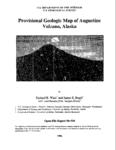Augustine Yellow Cliffs Debris Avalanche
Start: 2160 yBP ± 60 Years [1]
Stop: 1830 yBP ± 80 Years [1]
Event Type: Not an eruption
Description: From Waitt and Beget (1996): "Between about 2100 and 1800 yr B .P. (between tepbra layers G and D) two large debris avalanches swept east and southeast to the sea."
"Overlying the G tephra (sparsely exposed) that caps the East Point debris-avalanche deposit is a highly oxidized massive diamict containing angular altered andesite boulders commonly 1-2 m in diameter, some as large as 3.5 m. This distinctively yellowish unit 5 to 9 m thick forms the middle to upper part of the sea cliff for at least 25 km along the east coast. The matrix and large clasts alike are strongly altered to soft zeolite (?) and clay, but the unit also contains sporadic pods meters in diameter of gray to reddish coarse diamict of scarcely altered andesite. Midway between East Point and Northeast Point its surface shows sharp local relief of 3-4 m where directly buried by the Northeast Point debris-avalanche deposit. At the south of Southeast Point the Yellow Cliffs diamict is overlain by the gray Southeast Point debris-avalanche deposit, which is capped by the I tephra."
"The hummocky surface topography and the massive and coarse texture clearly identify the Yellow Cliffs diamict as a debris-avalanche deposit. The enclosed pods of unoxidized diamict and the fact that the unit is both overlain and underlain by unoxidized to weakly oxidized similar diamicts shows that the heavy alteration had occurred before the avalanche."
"During this prehistoric period numerous domes must have been emplaced at the summit, repeatedly renewing the source for catastrophic debris avalanches. Remnants of these older domes form the east and south sides of the present summit-dome complex. Below the summit area at least three domes were emplaced on the upper flanks, one on the south (Karnishak dome), two on the northwest (domes "I" and "H"). Another undated and nearly buried dome or lava flow diversifies the upper south flank."
"Overlying the G tephra (sparsely exposed) that caps the East Point debris-avalanche deposit is a highly oxidized massive diamict containing angular altered andesite boulders commonly 1-2 m in diameter, some as large as 3.5 m. This distinctively yellowish unit 5 to 9 m thick forms the middle to upper part of the sea cliff for at least 25 km along the east coast. The matrix and large clasts alike are strongly altered to soft zeolite (?) and clay, but the unit also contains sporadic pods meters in diameter of gray to reddish coarse diamict of scarcely altered andesite. Midway between East Point and Northeast Point its surface shows sharp local relief of 3-4 m where directly buried by the Northeast Point debris-avalanche deposit. At the south of Southeast Point the Yellow Cliffs diamict is overlain by the gray Southeast Point debris-avalanche deposit, which is capped by the I tephra."
"The hummocky surface topography and the massive and coarse texture clearly identify the Yellow Cliffs diamict as a debris-avalanche deposit. The enclosed pods of unoxidized diamict and the fact that the unit is both overlain and underlain by unoxidized to weakly oxidized similar diamicts shows that the heavy alteration had occurred before the avalanche."
"During this prehistoric period numerous domes must have been emplaced at the summit, repeatedly renewing the source for catastrophic debris avalanches. Remnants of these older domes form the east and south sides of the present summit-dome complex. Below the summit area at least three domes were emplaced on the upper flanks, one on the south (Karnishak dome), two on the northwest (domes "I" and "H"). Another undated and nearly buried dome or lava flow diversifies the upper south flank."
References Cited
[1] Volcanic processes and geology of Augustine Volcano, Alaska, 2009
Waitt, R.B., and Beget, J.E., 2009, Volcanic processes and geology of Augustine Volcano, Alaska: U.S. Geological Survey Professional Paper 1762, 78 p., 2 plates, scale 1:25,000, available at http://pubs.usgs.gov/pp/1762/ .[2] Provisional geologic map of Augustine Volcano, Alaska, 1996
Waitt, R. B., and Beget, J. E., 1996, Provisional geologic map of Augustine Volcano, Alaska: U.S. Geological Survey Open-File Report 96-0516, 44 p., 1 plate, scale 1:25,000.[3] Preliminary volcano-hazard assessment for Augustine Volcano, Alaska, 1998
Waythomas, C. F., and Waitt, R. B., 1998, Preliminary volcano-hazard assessment for Augustine Volcano, Alaska: U.S. Geological Survey Open-File Report 98-0106, 39 p., 1 plate, scale unknown.[4] Cyclic formation of debris avalanches at Mount St Augustine volcano, 1992
Beget, J. E., and Kienle, J., 1992, Cyclic formation of debris avalanches at Mount St Augustine volcano: Nature, v. 356, n. 6371, p. 701-704.Complete Eruption References
Provisional geologic map of Augustine Volcano, Alaska, 1996
Waitt, R. B., and Beget, J. E., 1996, Provisional geologic map of Augustine Volcano, Alaska: U.S. Geological Survey Open-File Report 96-0516, 44 p., 1 plate, scale 1:25,000.

Preliminary volcano-hazard assessment for Augustine Volcano, Alaska, 1998
Waythomas, C. F., and Waitt, R. B., 1998, Preliminary volcano-hazard assessment for Augustine Volcano, Alaska: U.S. Geological Survey Open-File Report 98-0106, 39 p., 1 plate, scale unknown.

Cyclic formation of debris avalanches at Mount St Augustine volcano, 1992
Beget, J. E., and Kienle, J., 1992, Cyclic formation of debris avalanches at Mount St Augustine volcano: Nature, v. 356, n. 6371, p. 701-704.
